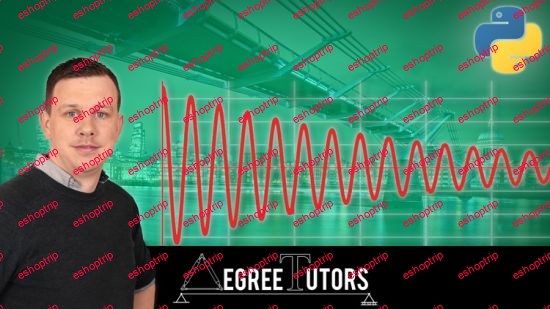Genre: eLearning | Language: English + srt | Duration: 36 lectures (7h 4m) | Size: 3.35 GB
Leverage fundamental structural dynamics to build your own flexible numerical solutions in Python
What you’ll learn:
You’ll learn what separates a static from dynamic analysis and the key role inertia plays
You’ll learn how to use Python to build flexible algorithms to model the influence of any form of general dynamic loading
You’ll learn how to model dynamic behaviour using spring-mass-damper models and how to simulate free vibration
You’ll learn how to model the influence of harmonic loading and how to characterise the transient and steady-state responses
Requirements
Basic math knowledge (pre-uni / high school level is fine)
A basic familiarity with programming concepts such as functions, loops and conditionals would be helpful but is not essential
Description
Welcome to this DegreeTutors course on the Fundamentals of Engineering Structural Dynamics with Python. This course has two simple objectives:
To help you build a solid understanding of structural dynamics
To equip you with practical tools you can deploy to analyse real world dynamic structural behaviour
Structural Dynamics is a topic that often intimidates students and practicing engineers. This can be a big problem because not having a good grounding in dynamics, means you can’t confidently simulate, understand and ultimately design for dynamic behaviour. From bridges, to skyscrapers, as engineers, we need to be confident modelling the impact of dynamic loads on our structures. If you’ve tended to shy away from dynamics or found it confusing and intimidating, this course is for you.
Each lecture is developed and delivered with the benefit of my experience as a university lecturer in structural engineering. New concepts are developed at a steady pace with material developed through hand-drawn notes and sketches. You’re encouraged to engage with each lecture by actively developing their own notes as you progress through the course…no ‘death by PowerPoint’ here! We’ll focus on pinning down the basics before diving into any code.
We’ll make use of Python throughout the course, but more so towards the second half. This is a hands on, learn by doing course – so there are no dry Python-only lectures, if you’re not familiar with Python – no problem, you’re going to learn what you need as we go…the same way most people learn to programme! This isn’t a ‘Learn Python’ course but you will learn the Python you need, along the way.
Section 1 – Statics versus Dynamics
In section one, we’ll get your coding environment set up. We’ll be using Jupyter Notebooks in this course. These are a hugely popular development environment used throughout science and engineering. This will allow us to get up and running with Python quickly.
After some initial housekeeping we’ll start to discuss the idea of statics versus dynamics and just what makes for a dynamic problem. This will lead us into a brief discussion of inertia. After completing this section you’ll know what differentiates a dynamic problem from a static one and when a dynamic analysis is called for.
Section 2 – Free Vibration of Single Degree of Freedom Systems
In this section we’re going to lay a lot of the groundwork and tackle much of the core theory in structural dynamics. We start by exploring lumped mass analysis and introduce the spring-mass-damper model. You can think of the spring-mass-damper model as a fundamental tool used to simulate dynamic behaviour.
We’ll spend the rest of this section examining the characteristics of this model and it’s free vibration behaviour. We’ll cover core concepts along the way such as natural frequency, damping regimes and the logarithmic decrement. We’ll finish out the section with some numerical worked examples and take our first dive into using Jupyter Notebooks.
Section 3 – Harmonic Excitation
This section it about understanding what happens when we introduce an external dynamic force to the system. In particular we’re going to focus on harmonic excitation. We’ll discuss why harmonic excitation is such a key phenomenon to understand and its broader relevance in dynamic analysis.
We’ll develop our understanding of transient and steady-state behaviour. We’ll then go on to characterise the steady-state behaviour and introduce the ideas of dynamic magnification factor and resonance. We’ll finish out this section with a pretty in-depth worked example that will demonstrate exactly how to practically implement everything you’ve learned in the course so far. Again, we’ll be doing this using Jupyter notebooks so you’ll get more exposure to implementing what you’ve learned in Python.
Section 4 – General Dynamic Loading
At this point we’re going to really focus in on giving you some tools to actually perform practical real-world dynamic analyses. We’ll start of by motivating our study of general dynamic loading with a brief case study discussion of human-induced vibration on the Clifton Suspension Bridge in Bristol. This case study highlights the need to have a more versatile dynamic analysis technique in your toolbox
That technique is the Piecewise Exact numerical solution method. This is a hugely versatile numerical solution technique that will equip you with the ability to go beyond harmonic excitation and simulate the influence of any time-varying force. We’ll develop the concept, then implement an algorithm in a Jupyter Notebook. The power and versatility of studying structural dynamics in a coding environment will be very apparent in this section. We’ll conclude this section by exploring some of the practical considerations when implementing this and any numerical solution technique.
Who this course is for
Undergraduate engineering students who want to get up to speed with structural dynamics
Students who’ve studied structural dynamics but got lost along the way
Working engineers who are a little rustier than they’d like to admit on dynamics
Engineers and students who want to see how they can leverage Python in their work
Engineers and students who want a practical technique to analyse realistic dynamic loads











Reviews
There are no reviews yet.